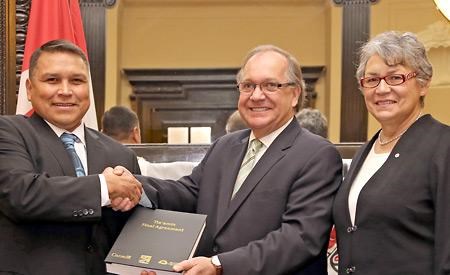Legislation was introduced Monday, April 28, in the House of Commons to ratify the Tla’amin final agreement. With unanimous support from all parties, the bill was passed at all stages.
The agreement gives Tla’amin (Sliammon) First Nation more control with self-government over lands, resources and members of the community. The provision of aboriginal rights and title are expected to provide a solid footing which will translate into economic benefits to the community as economic opportunities and infrastructure continue to be developed.
Tla’amin Nation entered the BC treaty process in May 1994. The final agreement was ratified by Tla’amin members through a community vote on July 10, 2012, and by March 14, 2013, the final agreement received royal assent. The signing by the three parties was completed April 11, 2014 when Minister of Aboriginal Affairs and Northern Development Bernard Valcourt added his signature to the final document.
“It’s exciting news,” Roy Francis, lead treaty negotiator for Tla’amin, said. “It passed through first, second and third reading. We did not expect that. With the legislation now in place, the final steps will take place when the matter goes to the senate.”
“We had a small delegation in Ottawa to attend the last sitting on the 11th of April,” Francis explained. “The process dictated that the agreement itself would be signed off by the federal minister. After the signing it was going to be introduced into the house.”
Francis said when Tla’amin first set out to explore the notion of becoming an independent nation within Canada the model for achieving treaty agreements was still something that was new. No one knew what to expect. “There was nothing specific in terms of a treaty process back then. The conversation was more about discovering who we are as a community.” He said the community identified what was important: more jobs, a healthier lifestyle, affordable housing. “Once we compiled our wish list we had to figure out where to go from there. How do we start digging in to make those things happen?”
“The signing of the Tla’amin Final Agreement and its introduction into Parliament marks a historic milestone for the Tla’amin Nation,” said Tla’amin Chief Clint Williams. “It honours our connection to our lands and history, and it begins our movement out from under the Indian Act.”
Tla’amin has approximately 1,000 members, 60 per cent of whom live in Sliammon. Via the federal agreement, Tla’amin claimed traditional territory covering more than 609,000 hectares.
“With the signing of this Final Agreement the Tla’amin Nation will benefit from increased control over their own affairs while being removed from significant parts of the Indian Act going forward,” said Valcourt. “The nation will have certainty over the ownership of land and resources, the ability to create new investment opportunities and ultimately, to make decisions determining their economic future. The British Columbia treaty process is delivering results, and our government will continue to work with first nations in British Columbia to conclude treaties in the best interests of all Canadians.”
Since 1973, across Canada 26 comprehensive land claims and three stand-alone self-government agreements have been concluded and are being implemented. Of the 26 concluded claims, 18 include provisions related to self-government. The agreement with Tla’amin is the fourth final agreement to be reached under the British Columbia treaty process.



